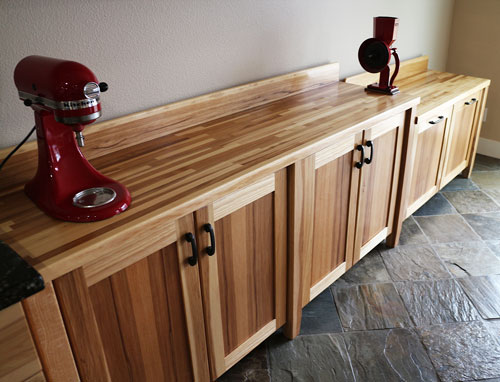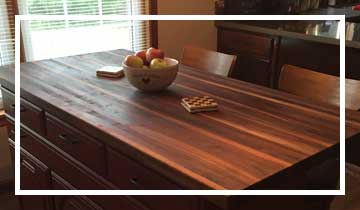Butcher Block Hickory Wood Stats
When it comes to durability and a distinct aesthetic appeal, one of our favorite butcher block woods is hickory! Hickory has lots of variation of coloration, which makes it visually stand out as a butcher block wood.
In fact, hickory wood often tops the list for woodworkers, chefs, and home renovators alike. Hickory butcher block wood is meticulously crafted from the hickory tree, a member of the Carya genus. This wood type is revered for its hardness, shock resistance, and intricate grain patterns.
Whether you're crafting furniture, installing hardwood flooring, or even considering a hickory butcher block countertops for your kitchen, it's helpful to understand the different species of hickory and their unique properties. Here are some hickory wood stats to know:
Hickory Wood Species
There are 18 known species of hickory in the world, with 15 native to North America and 3 to East Asia. Species of hickory include the Carya texana (black hickory), Carya floridana (scrub hickory), Carya glabra (pignut hickory), Carya laciniosa (shellbark hickory), Carya myristiciformis (nutmeg hickory), Carya ovalis (red hickory), Carya ovata (shagbark hickory), Carya pallida (sand/pale hickory), etc.
Here are a handful of North American-native hickory wood species that may be used for butcher block craftsmanship or other types of applications. Let's talk about all the options for your hickory wood:
Shagbark Hickory (Carya ovata)
Native to the Eastern United States, Shagbark hickory has a light to medium brown coloration and a coarse texture. It earned its name thanks its shaggy bark, which peels away in large pieces. The Shagbark hickory tree can grow to heights of 60 to 80 feet and can tolerate a wide range of weather conditions.
- Location: Eastern United States
- Wood Characteristics: Light to medium brown color, coarse texture, and straight grain
- Common Uses: Tool handles, cabinetry, flooring, and rustic furniture
- Durability: This type of hickory wood is highly durable and resistant to wear
Pignut Hickory (Carya glabra)
Also mainly found in the Eastern United States, the Pignut hickory is a dark-gray colored tree that can reach 50 to 60 feet in height and is hardy in most soil conditions, including salty soil and drought.
- Location: Eastern United States
- Wood Characteristics: Light to medium brown with slightly reddish hues
- Common Uses: Furniture, cabinetry, and some musical instruments
- Durability: Similar to Shagbark Hickory in terms of hardness and wear resistance
Shellbark Hickory (Carya laciniosa)
Another shaggy gray-bark species to consider for your hickory butcher block countertops, the Shellbark hickory requires large areas of well-drained soil. It can grow up the 75 to 100 feet in height and can extend to 50 to 75 feet wide. It's found primarily in the Midwest and along the Mississippi River.
- Location: Midwest, along the Mississippi River
- Wood Characteristics: Light to medium brown, grain pattern is intricate but uniform
- Common Uses: Woodworking for furniture and specialty products like sports equipment
- Durability: Comparable to other hickory woods, highly durable and shock-resistant
Mockernut Hickory (Carya tomentosa)
The mockernut hickory, also known as the mockernut, white hickory, whiteheart hickory, hognut, and bullnut is a true hickory tree that grows throughout a widespread region in the Eastern United States. The mockernut is about to grow up to 50 to 60 feet.
- Location: Widespread in Eastern United States
- Wood Characteristics: Light to medium brown with a tint of yellow, with straight grain with a possibility of unique variations for hickory butcher block applications
- Common Uses: Furniture, tool handles, and veneer
- Durability: Strong and reliable
Pecan Hickory (Carya illinoinensis)
This beautiful tree grows in the Southern states of the US and also Mexico. The pecan hickory grows the sweetest nuts when compared with other types of hickory trees and can grow to heights of 70 to 100 feet. Also, it's a slightly softer hickory wood than its other hickory cousins.
- Location: Southern United States and Mexico
- Wood Characteristics: Light to medium brown with reddish hues, grain is usually straight but can be wavy
- Common Uses: Furniture, veneer, paneling, and flooring
- Durability: Comparable to other hickory species, but slightly softer
Bitternut Hickory (Carya cordiformis)
The bitternut hickory grows best in moist conditions and it needs a large area to grow and thrive. As it matures, it can reach a height of 50 to 70 feet height. The bitternut hickory is found widespread throughout the Eastern United States.
- Location: Widespread in Eastern United States
- Wood Characteristics: Light in color, usually yellowish with a tinge of brown, grain is straight
- Common Uses: Tool handles, ladder rungs, and utility woodworking
- Durability: Highly durable
Notes on Janka Rating
If you're not already familiar with the Janka hardness test, it is an industry standard that's used to measure the ability of a type of wood to withstand wear and denting. The test involves measuring the amount of force required to embed a 0.444-inch steel ball halfway into a piece of wood.
The result is stated in pounds-force (lbf) to indicate the wood's hardness and durability.

Hickory Wood Janka Rating
Hickory wood Janka hardness is measured at about 1,820 to 2,000 lbf. This makes it one of the hardest and most durable domestic woods available in the United States. The exact hardness of the hickory wood can vary depending on the specific hickory species you've chosen for your butcher block.
Other factors include the tree's growing conditions. Overall, hickory is considered a very hard and durable wood and a popular choice for butcher block.
Order a Custom Desk Here
Hickory Wood Species Frequently Used in Butcher Blocks
When it comes to butcher block, hickory wood clearly stands out for its durability and aesthetic appeal. The most commonly used species for butcher block woods are Shagbark and Pignut Hickory. Their inherent hardness and shock resistance make them ideal for withstanding everyday kitchen use. Their coarse grain structure is not just visually appealing but also provides extra resistance against wear and tear and moisture makes it more than suitable for kitchen applications.
Hickory wood, with its variety of species and durable qualities, is a top choice for various types of butcher block types, including countertops, bar tops, desktops, cutting boards, kitchen islands, and tables. Take a look at some ideas for hickory butcher block kitchen countertops.
Contact Us for Hickory Wood Butcher Block!
At Forever Joint Tops, we highly recommend hickory because it offers a blend of durability and aesthetic charm that's hard to beat. So, the next time you find yourself considering wood types for your projects, whether they be in the kitchen or the workshop, hickory is a strong contender that you should seriously consider!
Ready to start your hickory wood project? Please contact the team at Forever Joint Tops or get a quote here for your own custom or pre-made hickory butcher block. We can help answer any questions you may have about the different types of hickory wood and which you should choose! For further reading, please take a look at our hickory faqs.
Order Your Butcher Block Here!


